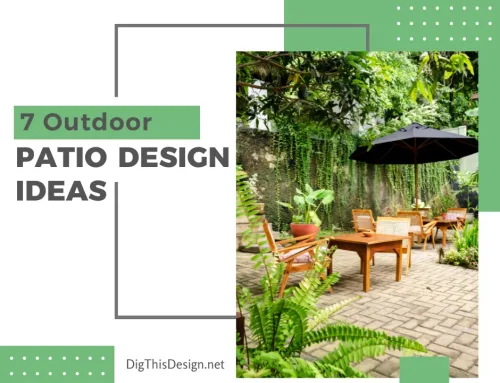Did you know that the curb appeal of your home can help you sell your home faster? With all the types of fences on the market today, why not consider installing a stunning fence around your home?
Are you wondering what types of fencing are available? Not to worry! In this guide, we’ll go over the different types of fences for you to consider. If this is something that interests you, we invite you to continue reading to learn some details about the different types of fences to enhance the beauty of your outdoor surroundings.
7 Types of Fences for your Property
① Vinyl Fences
Vinyl fencing comes in different colors and styles. If you like, consider ordering vinyl picket style fencing. The installation isn’t complicated on flat ground but gets tricky on slopes so be sure you’re selecting the right fencing for your geography.
Vinyl is also great if you want something that’s fire-resistant and doesn’t get damaged by rot or termites. Additionally, you don’t need to worry about staining or painting with vinyl.
Also, although some vinyl fencing gets mold, it’s fathoms easier to clean than a wood fence with mold. In fact, to maintain the fencing, all you have to do is rinse with water.
Finally, while it’s true that vinyl fencing costs more up front than wood fencing, it lasts longer and is more durable in the long run.
② Wrought Iron Fences
Wrought iron fences are sturdy and durable and they don’t scratch or dent like other types of fencing.
As a design feature, Victorian homes look excellent with well-designed iron fences. Or, you can choose to install a pretty wrought iron fence around your garden for an extra special Victorian effect.
Some people choose cap the points on the Victorian fencing. This is helpful if you live in the country because they keep deer from jumping over the fence and destroying your yard or garden.
However, there are lots of styles of wrought iron fences on the market today, both modern and vintage.
Interestingly, one drawback of a wrought iron fence is that it could flake or rust over time if you don’t maintain it. This type of fencing is also quite heavy.
The maintenance isn’t too time-consuming or complicated for wrought-iron fencing. Simply set up your maintenance schedule to apply a coat of clear linseed oil or liquid wax. Then, rinse the fence with soapy water.
Get rid of rust by using steel wool and a commercial rust remover. Additionally, every five years, schedule an application of good protective paint. Restoration is also possible for your wrought iron fencing through sandblasting, hand-scraping, or wire-brushing.
③ Wood Fences
There are many different varieties and styles to consider. You can look into durable species like redwood, cedar, and tropical hardwoods.
Over time, a fence turns gray or rots if you don’t seal it. Also ensure that you use non-rusting fasteners to help prevent staining the wood. The downsides are that wood fences can split or dent if they get hit by a mower or other large object. Also, wood is one of the heavier types of fencing.
Wood fencing needs it own special kind of care. For instance, it needs an application of water repellent sealer that contains a wood preservative. So, put this on your maintenance calendar for one sealer application per year. Then, put stained or painted wood on a two-year maintenance schedule for scraping, painting, or staining.
If you choose a wood fence, consider redwood or cedar because both types of wood are insect and rot-resistant. They are also lighter weight compared to other wood types.
What’s more, redwood and cedar don’t need staining or painting. Instead, they naturally weather to a beautiful brown or gray finish.
Treated softwoods like pine wood are also resistant to rotting. However, they also need staining or painting. Without staining or painting, the wood will become unpleasantly discolored after exposure to the elements.
Wood planks are an excellent option if you’re looking for more privacy. Most municipal codes have a maximum height limit for the side, back, and front fences. So, be certain to check with your local officials first to save yourself time and money.
A wood picket is another option if you’re looking for something more informal and airy. White picket fences are always a classic look for your design.
Additionally, you can purchase irregular cut cedar boards that appear wavy. You might also look for peeled tree branch segments that look rustic. This type of fence looks especially nice enhancing your lodge or ranch style home.
④ Farm Fences
If you need to divide your farmland into pastures, consider woven wire fences. With your livestock or horses, this type of fence keeps them inside your property but also protects them from injuries.
Also, consider a flexible vinyl rail fence or galvanized steel fence. Both will give way when hit to help lower the chances of leg injuries.
The farm fence that is galvanized will add durability and protect it from the elements. Also, a single strand of barbed wire added to the top will keep animals from leaning on the fence.
⑤ Contoured Fences
Do you have a sloped yard? If that is the case, look into a stepped or contoured fence. Interestingly, the rails of contoured fencing will follow the slope of the yard.
A stepped fence features fence posts that run downhill in a series of steps while the slope of every post drops.
If you’re looking for a privacy fence, look into a Simtek fence installation.
⑥ Pool Fences
Do you have a pool in your backyard? For safety regulations, you may need to install a pool fence.
Find out what the rules and building codes are for pool safety standards. Make sure you look into this before the installation.
⑦ Invisible Fences for Animals
Do your dogs like to wander off your property or chase vehicles? Consider installing an in-ground invisible fence.
This fencing system enables you to set specific protective boundaries in which the dog hears a sharp alarm and feels a mild static correction if they go near the border.
Here’s to Selecting the Right Types of Fences for Your Yard!
We hope you found this guide on fencing types helpful. Now that you know about types of fences think about what works best for your property. If you have any questions, we would love to hear from you in the comments below. You will also find other great links to all things design directly below.
Images Courtesy of Canva.
Using Solar Power: 4 Things to Consider for Your Home
Qualities of a Good Mattress You Should Know
8 Most Beautiful Types of Palm Trees to Consider for Your Home
Green Home Ideas: Choose The Best Eco-Friendly Items For Your Home





